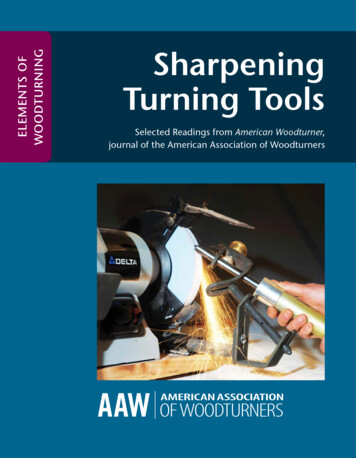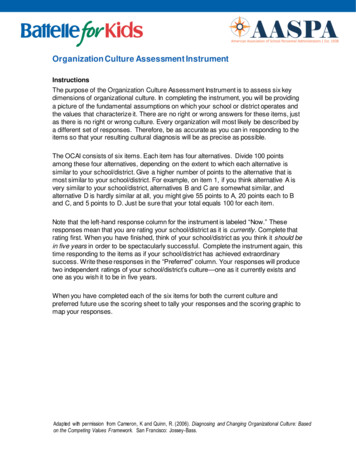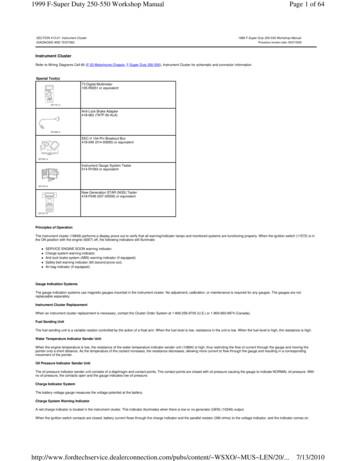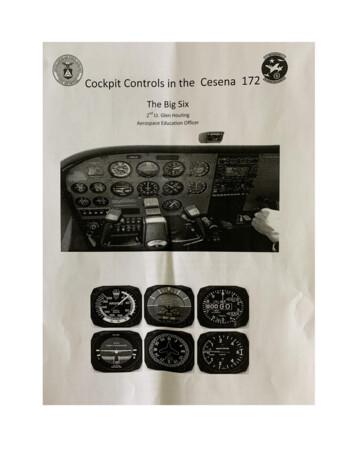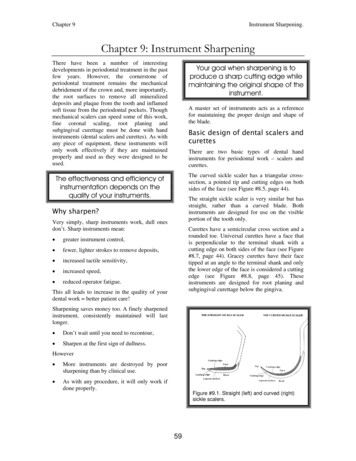
Transcription
Chapter 9Instrument Sharpening.Chapter 9: Instrument SharpeningThere have been a number of interestingdevelopments in periodontal treatment in the pastfew years. However, the cornerstone ofperiodontal treatment remains the mechanicaldebridement of the crown and, more importantly,the root surfaces to remove all mineralizeddeposits and plaque from the tooth and inflamedsoft tissue from the periodontal pockets. Thoughmechanical scalers can speed some of this work,fine coronal scaling, root planing andsubgingival curettage must be done with handinstruments (dental scalers and curettes). As withany piece of equipment, these instruments willonly work effectively if they are maintainedproperly and used as they were designed to beused.Your goal when sharpening is toproduce a sharp cutting edge whilemaintaining the original shape of theinstrument.The effectiveness and efficiency ofinstrumentation depends on thequality of your instruments.The curved sickle scaler has a triangular crosssection, a pointed tip and cutting edges on bothsides of the face (see Figure #8.5, page 44).A master set of instruments acts as a referencefor maintaining the proper design and shape ofthe blade.Basic design of dental scalers andcurettesThere are two basic types of dental handinstruments for periodontal work – scalers andcurettes.The straight sickle scaler is very similar but hasstraight, rather than a curved blade. Bothinstruments are designed for use on the visibleportion of the tooth only.Why sharpen?Very simply, sharp instruments work, dull onesdon’t. Sharp instruments mean: greater instrument control, fewer, lighter strokes to remove deposits, increased tactile sensitivity, increased speed, reduced operator fatigue.Curettes have a semicircular cross section and arounded toe. Universal curettes have a face thatis perpendicular to the terminal shank with acutting edge on both sides of the face (see Figure#8.7, page 44). Gracey curettes have their facetipped at an angle to the terminal shank and onlythe lower edge of the face is considered a cuttingedge (see Figure #8.8, page 45). Theseinstruments are designed for root planing andsubgingival curettage below the gingiva.This all leads to increase in the quality of yourdental work better patient care!Sharpening saves money too. A finely sharpenedinstrument, consistently maintained will lastlonger. Don’t wait until you need to recontour, Sharpen at the first sign of dullness.However More instruments are destroyed by poorsharpening than by clinical use. As with any procedure, it will only work ifdone properly.Figure #9.1. Straight (left) and curved (right)sickle scalers.59
Chapter 9Instrument Sharpening.Determining theyour instrumentsThe terminal shank is an important landmarkwhen sharpening instruments. It is that portion ofthe instrument between the blade and the firstbend in the shank of the instrument. Whensharpening, you will be looking for the terminalshank, as you must align this portion of theinstrument with the sharpening guide to ensure aproper sharpening angle.sharpnessofThere are three ways of determining if aninstrument requires sharpening.1.Glare Test: a sharp cutting edge does notreflect light, but a dull one does. If you seelight reflecting from the cutting edge, theinstrument is quite dull.Figure #9.2. The terminal shank is the portion of the instrument between the cutting blade and the first bend inthe instrument. This is the portion that must be aligned at the proper angle to the sharpening stone.60
Chapter 9Instrument Sharpening.3.Clinical Performance: Once you have hadthe pleasure of working with sharpinstruments, you will develop a tactile senseof when an instrument is losing its edge.Tools for instrument sharpeningIn order to do any job properly, you need theright tools. Fortunately, sharpening of dentalinstruments does not require very much.The first things you will need are a tidy, smooth,firm work surface and a comfortable seat. Youwill also need a source of light andmagnification. A head-mounted light source andmagnifying head loupe work well if you havethese. Otherwise, a hobbyists magnifying tasklamp is an excellent choice.For sharpening the instruments, you also needstones of some sort. Many type are available. Irecommend that you obtain two grits of syntheticwater slip stones (available from Lee ValleyTools). A 1000-grit stone is a coarse stone forrecontouring damaged and very dull instruments.A 4000-grit stone is much finer and is used tocreate and maintain a smooth surface and a finecutting edge. These synthetic stones should belubricated with water and rinsed periodically toremove sludge (stone grit, metal fillings andwater) and keep the surface from becomingclogged. They can also be autoclaved at day’send.Figure #9.3. The sharp cutting edge does notreflect light but the dull edge will.2.Acrylic Test Stick: a more sensitive test is touse an acrylic test stick. The stick is heldfirmly in the non-dominant hand. Theinstrument is held in a modified pen graspand placed against the acrylic with the facebetween 80 and 90 degrees to the long-axisof the stick. The cutting edge is first pulledgently in toward the stick and then anattempt is made to pull the instrument up thestick. If the cutting edge bites into theacrylic, the instrument is sharp. If theinstrument does not bite in but slides alongthe acrylic, the instrument is dull.Figure #9.4. An acrylic test stick being used tojudge the sharpness of an instrument.Figure #9.5 A hobbyist’s lamp provides excellentillumination and magnification at a reasonable cost.61
Chapter 9Instrument Sharpening.Figure #9.7. For sharpening the lower edge of aGracey curette, the terminal shank is alignedwith one of the 110-degree lines and the stonealigned with the other.Figure #9.6. Proper angle between the face of theinstrument and the sharpening stone. In the photo, theinstrument and stone are aligned with the aid of adisposable sharpening guide available from D-SharpDental Instruments. As it is a scaler, the terminal shankis aligned vertically and the stone aligned with the 110degree line.Divide the instrument blade into three sections:heel, middle, toe/tip.The cutting edges of scalers and curettes aresharpened using the flat surface of the stones.The rounded sides of the stones can be used forsharpening the concave surface of dental andperiosteal elevators.Pads of disposable sharpening guides areavailable (D-Sharp Dental Instrument). Such aguide can easily be made with a math protractorand then laminated to the sharpening bench withclear packing tape. These guides allow you toeasily maintain the desired angle between thesharpening stone and the instrument to maintainthe proper angle between the face of theinstrument and the lateral side. Stabilize the instrument at proper angle onsharpening guide. Place the stone against the instrument at theheel while maintaining the proper anglebetween instrument and stone. Using short, rhythmic strokes and lightpressure, move the stone up and down alongthe guide line.Sharpening TechniqueFor all scalers and universal curettes, align theterminal shank of the instrument with the verticalcentral line and align the stone with either of theslanting 110-degree lines. For all Graceycurettes, align the terminal shank with one of the110-degree lines and align the stone with theother (remember that with Gracey curettes, youonly sharpen the lower edge of the face.Figure #9.8. Different portions of the blade of a curetand a scaler.62
Chapter 9Instrument Sharpening.ABCFigure #9.9. Keeping the original shape of the instrument in mind, try to maintain that shape as you sharpen.The cross-section A is the same as the new instrument to the left. Cross-section B has been sharpened at toosteep an angle, which produces a sharp edge, but it will not last long. Cross-section C has been sharpened attoo shallow an angle and so the instrument will be inclined to slide along the tooth surface rather than cuttinginto deposits. Gradually move from the heel to the middleto the toe/tip of the instrument. Apply slightly more pressure on the downstroke and finish each section with a downstroke. Maintain the proper angle and keep stone incontact with the instrument at all times.Always keep the original shape of the instrumentin mind and try to maintain that shapethroughout sharpening.When sharpening a scaler, try to maintain a sharppoint at the tip, but when sharpening a curette,maintain a rounded toe.Figure #9.11. If care is not taken to move fromheel to mid-section to toe, sharpening allsection equally, the curve may be flattened out.Figure #9.12. The universal curette in the centrehas been sharpened properly so that even thoughthe blade is thinner than the new instrument on theleft, the shape has been maintained. The instrumenton the right has been sharpened too much at thetoe, creating a sharp tip. This can be corrected byusing the stone to round off the tip and recreate atoe.Figure #9.10. From left to right, this drawingshows the proper blade shape for a universalcurette, a Gracey curette, a curved sickle scalerand a straight sickle scaler. Note that the Graceycurette’s blade is curved when viewed from thetop. The edge on the outside of the curve is thecutting edge.63
Chapter 9Alternate methodstone and bladeInstrument Sharpening.foraligningSharpening other dental/surgicalinstrumentsAnother method for maintaining the properangles between the stone and the lateral surfaceof the instrument uses the face of a clock as aguide. In this system, the terminal shank of ascaler or universal curette is aligned vertically(the 12:00 position) and the stone is aligned topoint to either 4 minutes to 12:00 or four minutesafter 12:00 depending on which side of the bladeis being sharpened.Dental and periosteal elevators and bonechisels/osteotomes need to be kept sharp foreffective use. Given the variety of shapes andsizes, it is not possible to provide detailed noteson this subject.For Gracey curettes, the terminal shank isaligned to point at 4 minutes to 12:00 and thestone at 4 minutes after 12:00 or vice versadepending on which side of the instrument isbeing sharpened.An instructional video and workbook on thissubject, entitled Its About Time, is produced byHu-Friedy and available from distributors thatcarry this line of instruments.Figure #9.14. This badly damaged elevator wasready for the trash, but was rehabilitated and madeready for use with a mechanical sharpening deviceseen in Figure #9.15.Figure #9.13. The face of a clock can be usedas a visual guide for aligning stone toinstrument. For universal curettes and scalers,the terminal shank lies along the second handand the stone lies along the minute or hourhand depending on which side is to besharpened. For Gracey curettes, the terminalshank is aligned along the hour hand and thestone along the minute hand or vice-versadepending on which side of the blade is to besharpened.Figure #9.15. The Rx Honing Machine. It comes witha diamond wheel for rapid grinding, a carbidecomposite wheel for fine sharpening and a leatherstrop wheel for a polished finish. There are also avariety of reciprocating stones that attach to the farside of the machine for a variety other sharpeningfunctions. The sharpening guide hovering over thewheel on the right is used to align scaler, curettesand scissors at the proper angle for sharpening.64
Chapter 9Instrument Sharpening.Final Thoughts Scalers and curettes may need to besharpened every 10 to 15 working strokes. Damages elevators can often be rehabilitatedthrough sharpening/grinding. Instruments and stones should be autoclavedafter each use. Retipping services are available to replacethe blades of worn-out or broken scalers andcurettes at a price far below replacementcosts. Mechanical sharpening aids such as the RxHoning machine can dramatically speed theprocess of instrument sharpening. However,if not used properly, they can alsodramatically increase the risk of ruininginstruments.AcknowledgementsSome photographs and illustrations and conceptsused in these notes were taken from the sourceslisted below:Smarten Up, Sharpen Up, published by HuFreidy of Chicogo, IL.Clinical Periodontology, published by W. B.Saunders of Philadelphia, PA.Maintaining the Edge by Rose Hartmannformerly of D-Sharp Dental Instruments,Burlington, ON.65
the guide line. Figure #9.8. Different portions of the blade of a curet and a scaler. Figure #9.6. Proper angle between the face of the instrument and the sharpening stone. In the photo, the instrument and stone are aligned with the aid of a disposable sharpening guide available from D-Sharp

